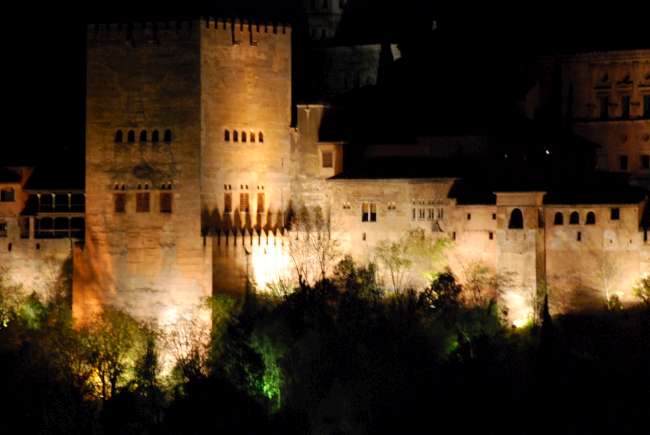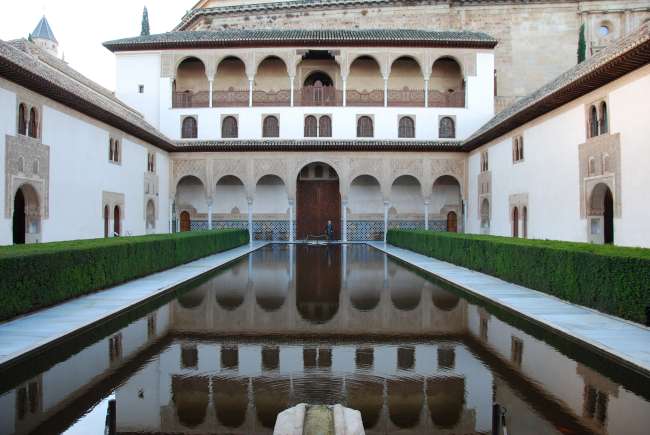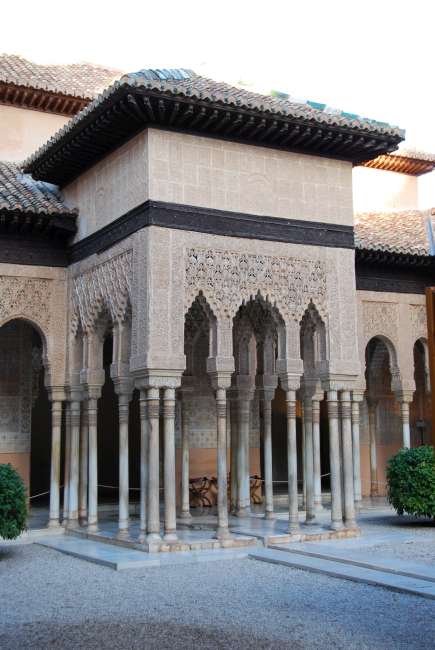
World Monument Photography
April 25, 2024
Granada is the best known Andalucian city for its Muslim legacy. After the fall of the Almohads, Andalucia disintegratred into Taifa kingdoms once again. After the Christian conquest of Kingdoms of Cordoba and Seville, the last remaining kingdom was Granada. To secure its survival, the Kingdom of Granada aided the Castilian kingdom in its siege of Seville in 1248. For 250 years, the Kingdom of Granada held on at the brink of extinction, but finally fell in 1492.

After the fall of the Caliphate of Cordoba, Granada became an independent kingdom in 1031 under the Zirid ruler Zawl. By 1200, it was the 5th largest city in the Iberian peninsula. In 1248, the Zirid dynasty was overthrown and the Nasrid dynasty began. Their first act was to aid the Castilian kingdom in its siege of Seville in 1248.
During the reign of Muhammad V (1362-1391), the Nasrid culture in Granada reached its height. The quality of their silks and textiles were among the best in the world. Their irrigation and agriculture techniques were among the most advanced in the world. He was also responsible for inscribing his motto into palaces everywhere: “There is no conqueror but God,” which is found inscribed all over the Alhambra palace. He greatly added to the Alhambra palace including the Patio de los Leones, a dozen marble lions guards a majestic alabster fountain. It was clear at this point that the energy of the people of Granada was channeled away from bolstering its defenses to refining its extravagance and luxury.
The fall of Granada happened over a large period of time. After the breakup of the Caliphate of Cordoba, Andalucia was broken up into several small petty kingdoms, or Taifas. The Christian north started to etch away city after city down into Andalucia. The fall of Toledo signaled a panic throughout Andalucia and prompted its people to request assistance from the militarily capable Almoravid Empire in North Africa. Upon their arrival to the Iberian peninsula in 1090 under the leadership of Tashafin, half of the Iberian peninsula was restored and the threat of a Christian invasion was neutralized. By 1212, the North African themselves became involved in internal conflicts that severely weakened them. This opened the door to the Christians to restart their conquests and Cordoba fell in 1236, Seville in 1248, leaving only Granada.
At this point, Granada acted as a refuge for hundreds of thousands of refugees fleeing Valencia, Codorba, and Seville. Exorbitant tribute was extracted from Granada by the Castilians in exchange for their safety.
It was not until the under the zeal of Pope Innocent VIII that the kingdoms of Castile and Aragon finally united with the marriage of Ferdinand and Isabel. Fueled with religous ferver and intolerance from the Roman Catholic church, they were convinced that they had a holy mission, a holy crusade, to exterminate the Kingdom of Granada. At the same time, the royal family in the Kingdom of Granada was suffering a fatal family feud. This feud involved Abul Hassan Ali (Mulay Hassan), ruler of Granada, and his son Muhammad XII, known as Boabdil. In an alliance with the Catholic monarchs, Boabdil sought to overthrow his father`s rule in exchange for Catholic`s guarantee that they will allow autonomy of internal affairs for the Kingdom of Granada once it is conquered. He even went as far as to obtain a guarantee from Pope Innocent VIII that Muslims will not be harmed and will be free to practice their religion once surrendering to the Catholic monarchs.

Mulay Hassan, on the other hand, was not so trusting of the Catholic monarchs and sought to fortify his positions. When Rodrigo Ponce de Leon struck at al-Hamma in 1482 in the Sierra, this signaled the beginning of the end of the Kingdom of Granada. Hassan sent his forces, but they were too late. He found the local mosque burned down, where women and children had taken shelter and massacred the remaining defenders of the town. Those who survived were sold into slavery. This pattern was to be repeated all over the Kingdom of Granada of the ten years to follow.
When Mulay Hassan returned to Granada, he found that his son has organized a rebellion against him. Mulay Hassan sided with his brother Muhammad al-Zeghal, the governor of Malaga. Al-Zaghal was the last great Muslim ruler of Andalucia. He was a gallant warrier, firm ruler, and a resolute opponent of the Christians. Boabdil, despised by the Christians, hated by the majority of Muslims for being supported financially, logistically, and worked on destroying the last combative powers of the kingdom. He did his best to foil the resistance of his uncle, al-Zeghal, against the Catholic monarchs; however, al-Zeghal fought with unwavering determination. Boabdil even promised peace and safety to cities that did not fight the Catholic monarchs. This led to divisions amongst Muslims and renewed outbreak of civil war between them: The Muslims of Albaicin engaged in street fighting with the supporters of al-Zeghal in the rest of the city. Granada eventually fell to Boabdil. In August 1487, Malaga fell and its inhabitants mutilated. After the defeat and capture of al-Zeghal in Almeria, the Catholic monarchs felt it no longer necessary to honor any agreement with Boabdil and demanded he hand over the keys of the city of Granada in 1492.
Boabdil was exiled to North Africa, where he was stripped of any rank or respect and spent the rest of his years being ridiculed and in humiliation and poverty as he was despised by all Muslims at this point. As for the Muslims of Granada, it was not long before Ferdinand and Isabel decreed that Iberian peninsula should be strictly a Catholic nation. All Muslims and Jews are to convert to Christianity or leave peninsula without their belongings. Many fled and many more converted. Those who converted to Christianity, but often only outwardly, were called Moriscos.

Moriscos were banned from public positions and status. They were required to wear upon their caps and turbans a blue crescent, which marked them for acts of violence and ridicule. Any Moriscos found traveling without a permit usually resulted in a death sentence. In May 25, 1566, Moriscos had to abandon the use of Arabic, change their costumes, their doors must remain open every Friday and other feast days, and baths are to be torn down. Possession of books or papers in Arabic was often punished with severe torture and/or death.
The Catholic clergy had much to do with the expulsion of the Muslims from Andalucia. The Inquisitions were instituted in the beginning of the sixteenth century. Over the course of a hundred years thousands were burned at the stake in the Spanish Inquisitions and many more were tortured. One method that was used to test a Moriscos` true faith is to pass a sword through them. If they die, then that means that their faith was not true. In another incident, Pope Clement VII, who is known for his piety, had order Charles V to rid his kingdom of Muslims and Jews. Those who did not convert should be killed, ordered to leave, or reduced to slavery. His successor, Pope Pius IV, also demanded that King Philip II end the scandal that has lasted for too long and the he must rid his land of the “diabolical sect” – referring to Moriscos. To further alienate and demonize the Moriscos, they were accused of every crime: treason, murder, kidnapping, blasphemy, and sacrilege. They were even accused of conspiring with the Ottoman Empire to overthrow the Spanish leaders.
Finally in 1609, all Moriscos were ordered to be expelled from Spain. From 1492 to 1609, it is estimated that 3 million Muslims were expelled from Spain and many more were killed. This sad episode in Spanish and Muslim history has shown that intolerance on one side and extravagance on the other can result in the worst crimes being committed against humanity that can persist for many generations.
Today, the Church of St. Maria occupies the site of the Great Mosque of Granada, the Church of St. Ana was also originally a mosque, and the towers of the churches of St. Jose and St. Juan de los Reyes utilize minarets of older mosques. After much controvery, Granada had its first mosque built a few years ago. It was not until 1988 that Spain finally repealed a law banning the practice of Islam on its lands.